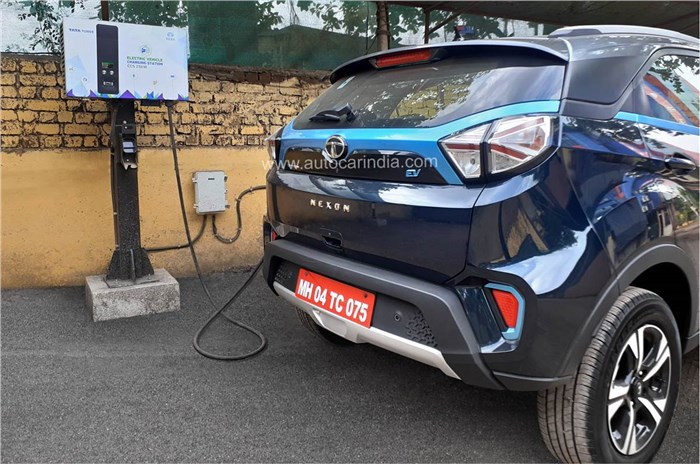Charging an EV can be as simple as plugging in a phone, but there are considerations to be kept in mind.
Published On Jul 29, 2023 10:30:00 AM
Living with all manner of electric vehicles, we’ve realised that before you even get to range anxiety, there’s sometimes plug-in worry. Not the nail-biting kind, but stuff like, will it charge fast enough, or why does your car have a different plug and can you charge it at any outlet? So here’s our guide to help you know more about charging an EV.
What are the different ways to charge?
15Amp
Let’s begin with the familiar 15A AC (Alternating Current) plug point. Yes, the broad 3-pin socket that you plug in your heavy-duty appliances at home can also power up your EV, and as the 15A point is pretty ubiquitous, it’s convenient. But with an output of just 3.3kW, it’s also slow.
.jpg&c=0)
Still, for a small battery, an overnight charge will easily top it up. For example, the Citroen eC3’s 29.2kWh battery pack can go from 10-100 percent in 10.5 hours on a wall socket. But larger batteries can take well over a day. So the 15A socket works best for small batteries like in electric two-wheelers and smaller cars, and since it’s easy to find, the 15A socket is also a good back-up in case you are stranded.
AC Fast charger
.jpg&c=0)
Next up is the AC wall charger. These are units that, like the 15A socket, also deliver AC power but at a higher wattage, typically somewhere between 7kW and 22kW. They are pretty compact, can be installed at homes and most companies offer such a charger with their products. For instance, the Tiago EV has an optional 7.2kW charger that can charge the 24kWh battery from 10-100 percent in 3 hours 35 minutes, whereas the standard 3.3kW charger takes 6 hours 20 minutes.
DC fast charger
In general, batteries function on direct current; even when you plug in your phone, the charger converts electricity from AC to DC to charge your phone’s battery. It’s the same with EVs too. However, you can bypass the AC to DC convertor of your EV and allow the batteries to soak in some direct current. You do this by plugging into a DC charger, which converts the grid’s alternating current to direct current and sends that straight to your battery. In this way, EVs so designed can handle a much higher charging rate. Taking the Tiago EV as an example again, Tata Motors says the 24kWh battery on a DC fast charger with a 50kW output will take 57 minutes to go from 10 to 80 percent.
.jpg&c=0)
These chargers aren’t for home use though, they are large and need special installation, and thus, are only found at specific public charging outlets. The speed of DC chargers is also increasing and today, some chargers can go up to 350kW. In India, companies like Kia, for example, have installed 240kW DC chargers, but remember, while your vehicle may be able to handle a DC charger, the maximum speed at which it will take on the direct current will depend on what it’s designed to handle plus other limiting factors, details of which we will get into later in this article. On a DC charger, you also have the option to select either the time, energy or total cost that you want to charge with.
V2V Charging
Much like siphoning fuel from one car to fill another, you can also use the battery charge of one vehicle to top up another, but this is generally very slow and best only if a car is stranded. For this to work, both vehicles – donor and recipient – need to be designed for V2V charging as beyond the ability to reverse the flow of electricity, both vehicles’ onboard power electronic systems need to be able to communicate with each other to allow the exchange to take place. This isn’t very common, but there are a few models capable of this; the Hyundai Ioniq 5 and Kia EV6, for instance. Besides this method, an EV low on charge can also be plugged into another EV that has a regular 3-pin AC outlet.
Does an EV charge at the same speed all through?
That’s a common query; most people expect the battery to charge at its maximum rate continuously. However, that’s not always the case. On slow and medium AC chargers, the power flow is at pretty much the same rate, so an EV will charge at roughly the same speed all through with only a small period of slow charging at the start and finish. However, on a DC charger, the power flow delivery is shaped like a step curve, which rises quickly and then descends as the vehicle charges. This is to protect the battery from overheating and overcharging individual cells. When a battery is in use – discharging or charging – it heats up, and to keep heat build-up in check, the charging pace is slowed as the battery gets fuller. Additionally, since no two cells are identical, they charge at slightly different speeds, thus, towards the end of any charge cycle when some cells are full and others may not be, the charging pace is slowed down so that empty cells can continue charging, while the full ones are not damaged.

The DC charging curve varies from model to model, typically the pace rises to a peak quickly, after which it gradually drops, and at 80 to 90 percent, it drops rapidly. This rapid slowdown post 80 percent is also why many EV owners feel that it’s good etiquette to not keep charging past that mark while on a public charger. The time taken is disproportionately long for the range gained, thus unplugging and allowing the next customer to charge is a nice thing to do. Charging to 80 percent is also a recommended way of preserving your battery life.
Other limiting factors
Ambient Temperature
There are other factors that also play a part in charging speed and one of them is ambient temperature. Remember Goldilocks, who didn’t like her porridge too hot or too cold? Batteries, too, are just like that and do not like extreme temperatures. The ideal operating temperature is roughly between 15 to 25°C, so in both very low or very high temperatures, the charging pace drops.
Load
Another factor is load. Most EVs allow you to use some systems while charging, for instance, you can sit inside your car with the HVAC system running while it charges. Naturally, this will take longer for your car to charge up, not just because the battery is also powering some systems, but also because the battery management system will slow things down to manage heat.
What are the different types of charger plugs available
As we had with mobile phones – and still do to a small extent – different EV manufacturers use different types of charging connectors and that’s based on the region they are from. And before you ask, it’s likely going to be a long while before there is a global standard.

Let’s begin with AC connectors: North American and Japanese manufacturers use the Type 1 – J1772 connectors, and these only make use of single phase electricity and are thus slow. The IEC 62196 – Type 2, also called the Mennekes connector, is used by the Europeans and can use the three-phase electric connection. Interestingly, it uses the same Type 1 – J1772 signalling or communication protocol, and thus, carmakers use either type of plug depending on the market it is sold in without having to reconfigure the entire charging system. China uses the GB/T connector, which looks much like the Type 2 plug, however, the cables are reversed and thus GB/T connector is not compatible with the Type 2. Meanwhile, Tesla uses its own propriety connector that can handle AC and DC current, however, some of its models like the Model X, which is sold in Europe, also have the Type 2 plug. In India, it’s the Type 2 that is in use, though early models like the Mahindra e2O and the older Tigor EV used different connectors.
Moving on to DC chargers, there are various types as well. Let’s start with the CCS (Combined Charging System), which is an interesting set-up wherein two additional pins are added to the bottom of the Type 1 and Type 2 AC plug, and thus, form the CCS 1 and CCS 2 plug, respectively. The added pins handle the actual charging, while the AC pins only handle the communication and Earthing. In this way, cars save space as they do not need two separate AC and DC ports, which is the case with the third type of DC charger – the CHAdeMO plug used by Japanese manufacturers in addition to the Type 1 AC plug. For DC charging, China also uses an additional GB/T plug with a different pin arrangement from the AC GB/T plug. Given that the Type 2 AC plug is used in India, the CCS 2 is in use for DC charging here.
Also See:
Switch EiV22 driven: Mumbai’s new electric double decker bus
Copyright (c) Autocar India. All rights reserved.

